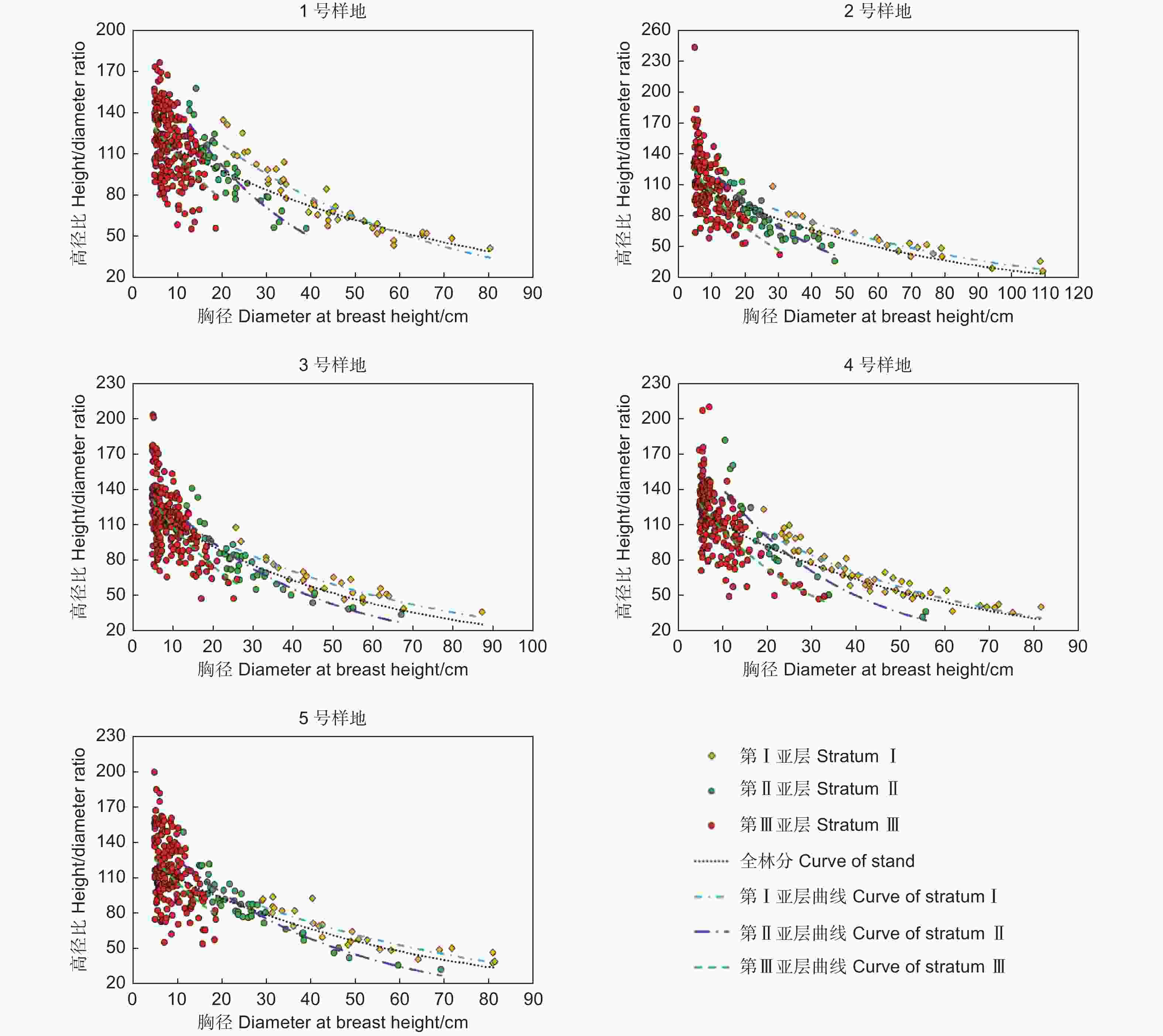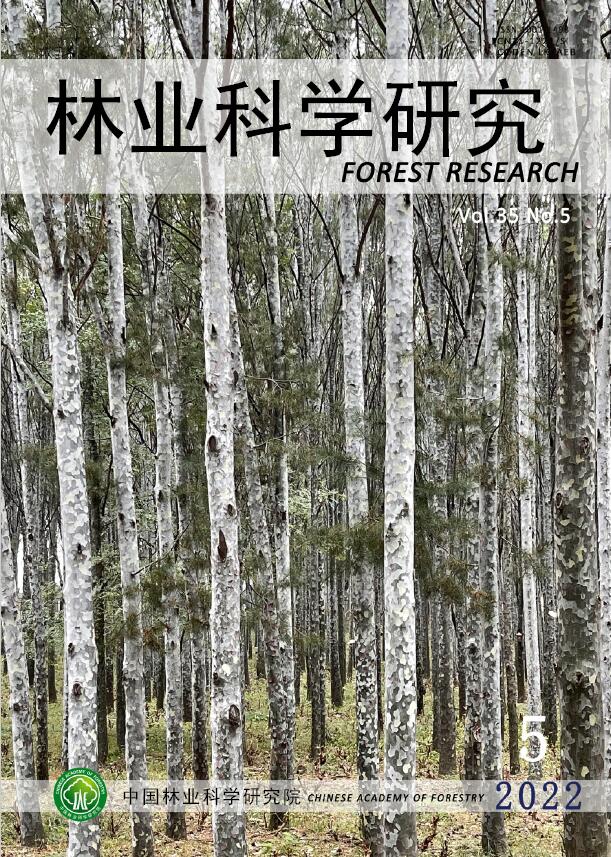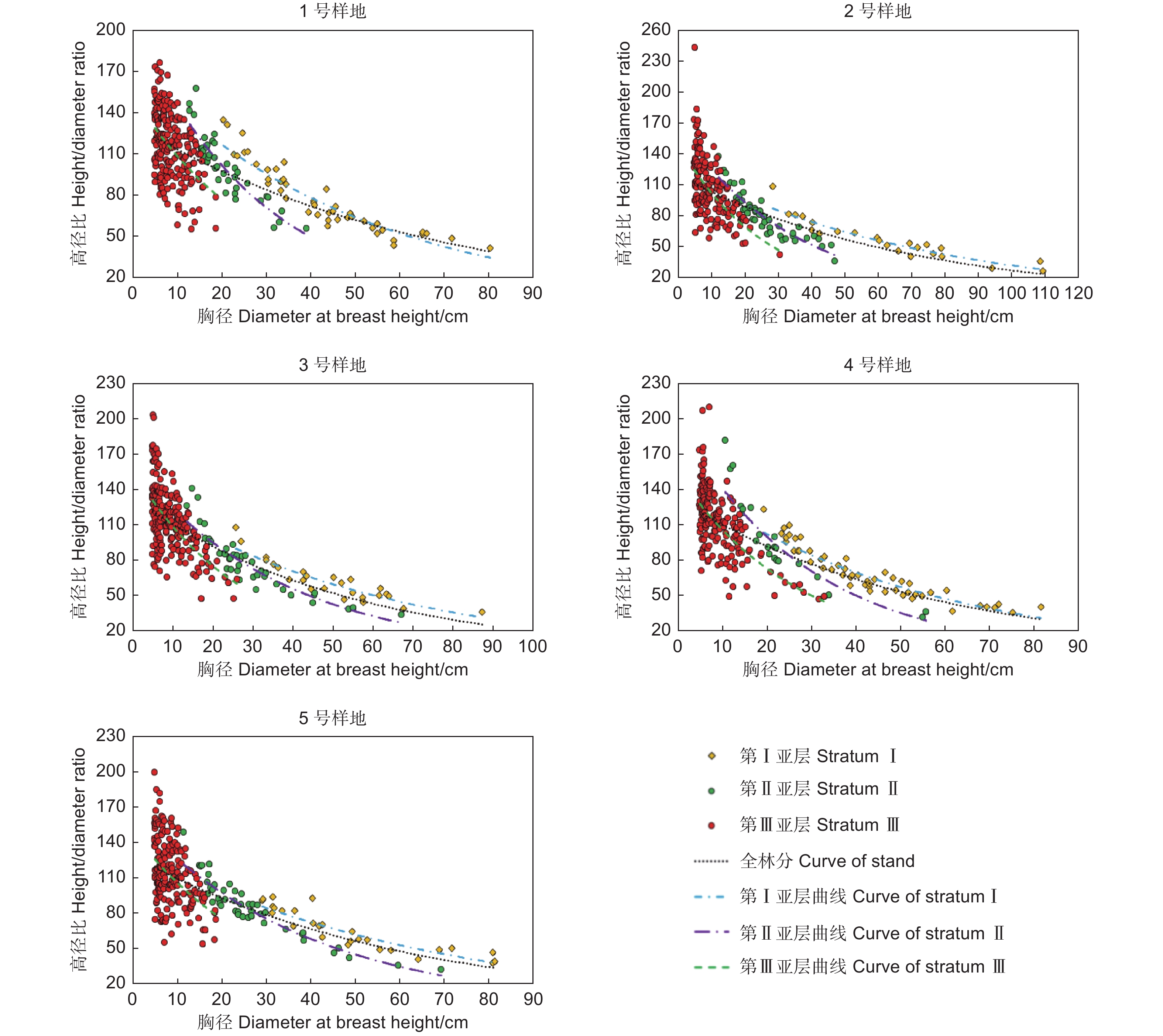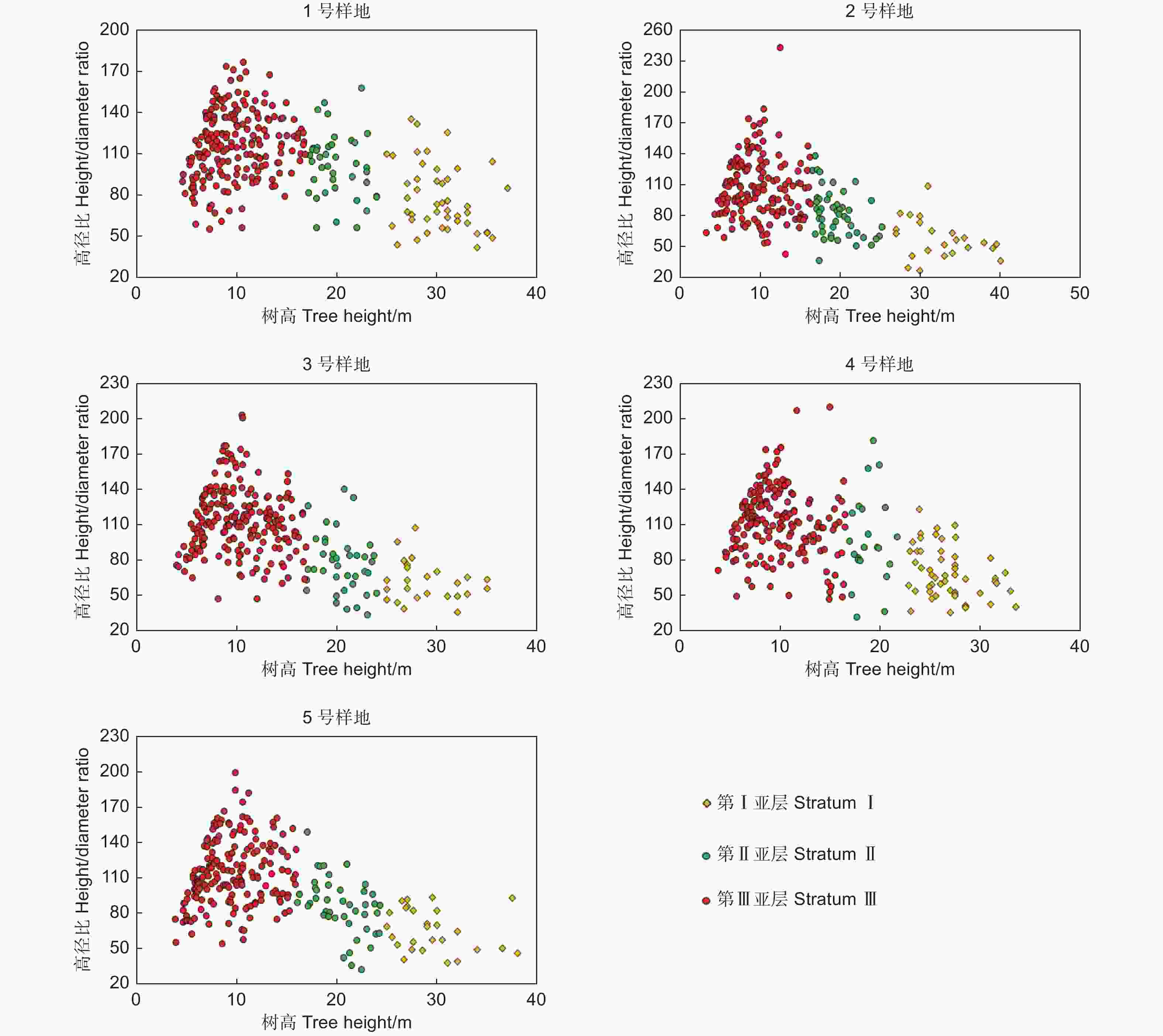-
高径比是衡量林分稳定性、密度和竞争的重要指标[1-5],可用于评估林木活力和健康状况[5-8],也可用于编制立木材积表以及确定立木生长率,还可在各种森林模型中作为描述竞争效应的显著预测因子[9]。高径比还是反映林木干形和林木生长的指标[10-12],它的大小直接影响木材的质量和经济价值[12]。高径比因林木大小、林木年龄、生长资源的可得性、林分密度和物种组成而异[5],研究高径比对于提升森林质量和木材产品价值有重要意义[5-8,12],同时对于更好地理解森林生态过程至关重要[3]。
为了更好地表征林木高径比特征,林木高径比与胸径及树高的关系引起了国内外一些学者的重视[13-15],林木高径比与胸径密切相关,其随林木胸径的增大而减小[15-17],其关系可用指数函数和双曲线函数来拟合[17-19],而林木高径比与树高的相关性通常不高,有时呈负相关[17],有时呈正相关[4]。但目前对林木高径比与胸径及树高关系的研究多是针对整个乔木层,很少基于各亚层 [3,16],且多是集中在结构简单、单层同龄的人工纯林,很少研究天然针阔混交林[17],未见针对结构复杂、复层异龄多树种混交的天然阔叶林的相关研究。对于中亚热带天然阔叶林的林层划分,目前已有科学的、在野外操作简单易行的和具有一定的生物学意义的林层定量划分新方法可供选用 [20-26]。因此,本研究以典型中亚热带天然阔叶林为对象,研究各林层(包括乔木层和各乔木亚层)林木高径比与胸径及树高的关系,旨在揭示典型中亚热带天然阔叶林各林层林木高径比与胸径及树高的关系特征,为中亚热带人工阔叶林、半天然林和天然阔叶林可持续经营提供阔叶林木高径比方面的参照。
-
建瓯万木林省级自然保护区是1957年划定的全国首批19个天然森林禁伐区(自然保护区)之一,是继鼎湖山之后我国建立的第二个自然保护区[27]。保护区位于闽北建瓯市境内,属武夷山南坡低山丘陵,海拔230~556 m,地理坐标为27°02′28″ ~ 27°03′32″ N,118°08′22″~118°09′23″ E,气候属中亚热带海洋性季风气候,年平均气温18.7 ℃,极端最低气温−5.9 ℃,极端最高气温40.7 ℃。年平均降水量1 700 mm,6月最多,雨日年平均166 d。土壤为中生代燕山运动侵入的花岗岩为主要成土母岩的红壤,立地类型以Ⅱ类地为主。
-
在建瓯万木林省级自然保护区内选择5个最典型中亚热带天然阔叶林[22-23,28],在5个试验林分内分别设置50 m × 50 m的样地,对样地内胸径≥5.0 cm的林木进行每木调查,准确调查测定并记录每株林木的位置、树种、胸径、树高、枝下高、冠长、冠幅和冠形等因子,采用最大受光面法进行林层划分[22-23]。各样地概况见表1,5个样地各林层的相关信息详见《中亚热带天然阔叶林林层特征》[24]、《基于林层的典型中亚热带天然阔叶林树种组成与多样性》[25]。
样地号
Sample plot群落类型
Community type种丰富度
Species
brichness平均胸径
Mean
DBH/cm平均树高
Mean
height/m密度
Density/
(individual·hm−2)蓄积量
Volume/
(m3·hm−2)1 木荷 + 光叶山矾
(Schima superba + Symplocos lancifolia)36 21.0 26.8 1 164 481.7 2 猴欢喜 + 木荷
(Sloanea sinensis + Schima superbar)50 25.7 27.9 952 591.5 3 木荷 + 新木姜子
(Schima superba + Neolitsea aurata)49 22.0 23.9 1 076 435.4 4 木荷 + 浙江桂
(Schima superba + Cinnamomum chekiangense)45 23.6 24.1 1 056 493.3 5 浙江桂 + 木荷
(Cinnamomum chekiangense + Schima superba)45 21.9 25.2 1 056 443.0 Table 1. General situation of sample plots
-
采用Spearman秩相关系数分析高径比与胸径及树高的相关性,运用指数函数和双曲线函数拟合林木高径比与胸径关系,参考前人的研究[17-19],选择以下2种模型对各林层(包括全林分和各亚层)林木高径比与胸径关系曲线进行拟合。具体表达式如下:
式中:y表示高径比的大小,x表示胸径大小,a和b是该模型的参数,(1)式中b表示林木高径比在连续的径阶中减小的速率;(2)式中a表示双曲线函数的上下限(b > 0时,a为下限;b < 0时,a为上限)。
选用均方根误差(RMSE)、决定系数(R2)和平均绝对误差(AMR)等作为模型评价指标。
-
各林层林木高径比平均值及其分布范围如表2,5个样地全林林木高径比平均值为103.1,分布范围为97.2~108.0,数值变动范围小(10.8);各亚层林木高径比平均值的数值变动范围也都不大,其中第Ⅲ亚层的数值变动范围最小(8.8);各亚层高径比平均值排序为:第Ⅲ亚层(112.7) < 第Ⅱ亚层(89.0) < 第Ⅰ亚层(66.9)。综合5个样地各林层林木高径比分布范围,全林为27.5~242.5,第Ⅰ亚层为27.5~135.0,第Ⅱ亚层为32.2~181.1,第Ⅲ亚层为43.5~242.5,各亚层最小值与最大值排序与其平均值排序一致。以上结果反映出:典型中亚热带天然阔叶林林木高径比会因所属亚层的不同而变化,因此有必要分亚层来探讨林木高径比与胸径及树高关系。
样地号
Sample plot平均林木高径比 Mean tree height-to-diameter ratio 林木高径比分布范围 Treeheight-to-diameter ratio range S Ⅰ Ⅱ Ⅲ S Ⅰ Ⅱ Ⅲ 1 108.0 78.2 101.4 116.2 42.5~175.9 42.5~135.0 56.4~157.3 55.7~175.9 2 97.2 58.1 82.2 107.4 27.5~242.5 27.5~109.2 37.2~138.2 43.5~242.5 3 103.8 62.8 77.7 114.0 34.5~202.9 36.8~108.2 34.5~140.5 47.8~202.9 4 102.2 69.4 97.8 112.0 32.2~209.0 35.9~123.2 32.2~181.1 47.3~209.0 5 104.1 66.1 85.9 114.0 32.5~198.8 38.4~94.0 32.5~148.4 54.2~198.8 注:S表示全林分;Ⅰ表示第Ⅰ亚层;Ⅱ表示第Ⅱ亚层;Ⅲ表示第Ⅲ亚层。下同。
Note: S means stand, Ⅰ mean stratum Ⅰ, Ⅱ mean stratum Ⅱ, Ⅲ mean stratum Ⅲ. The same below.Table 2. Mean tree height-to-diameter ratio and distribution range of tree height-to-diameter ratio in each stratum
-
各样地各林层林木高径比与胸径及树高关系的散点图如图1和图2所示,从散点图可以直观看出:各样地各林层林木高径比与胸径都呈现明显的负相关;各样地各林层林木高径比与树高的关系较为复杂,全林的关系呈现较为明显的负相关,但各亚层的关系较难以判断。进一步的相关性分析结果(见表3)表明:各样地各林层林木高径比与胸径均呈现极显著负相关且相关系数都较高,相关系数绝对值第Ⅰ亚层(0.896~0.961)和第Ⅱ亚层(0.912~0.971)最高,全林(0.613~0.749)居中,第Ⅲ亚层(0.415~0.596)最低;各样地各林层林木高径比与树高的关系较为复杂且相关系数绝对值都较低(0.020~0.480),全林呈现极显著负相关,第Ⅰ亚层4个样地呈现无显著负相关、1个样地呈现显著负相关,第Ⅱ亚层2个样地呈现极显著负相关、2个样地呈现无显著负相关、1个样地呈现无显著正相关,第Ⅲ亚层2个样地呈现极显著正相关、3个样地呈现无显著负相关。以上研究结果表明,同一亚层的林木高径比也会因胸径不同而变化;各林层林木高径比与胸径关系曲线拟合是有意义且必要的,但各林层林木高径比与树高关系曲线拟合是没有意义的;典型中亚热带天然阔叶林林木高径比特征可以采用各林层林木高径比与胸径的关系曲线来表达。

Figure 1. Scatter diagram and fitting curve of tree height-to-diameter ratio and DBH in each stratum
样地号
Sample plot高径比与胸径的相关系数
Correlation coefficient between
height-to-diameter ratio and DHB高径比与树高的相关系数
Correlation coefficient between
height-to-diameter ratio and tree heightS Ⅰ Ⅱ Ⅲ S Ⅰ Ⅱ Ⅲ 1 −0.613** −0.961** −0.912** −0.436** −0.283** −0.286 −0.169 0.208* 2 −0.749** −0.958** −0.953** −0.596** −0.456** −0.311 −0.408** −0.020 3 −0.742** −0.896** −0.942** −0.560** −0.458** −0.051 −0.211 −0.046 4 −0.729** −0.957** −0.971** −0.560** −0.431** −0.310* 0.119 −0.022 5 −0.657** −0.928** −0.923** −0.415** −0.330** −0.262 −0.480** 0.233** 注:*表示高径比与树高或与胸径有显著相关;**表示高径比与树高或与胸径有极显著相关。
Note: *means that the height-to-diameter ratio is significantly correlated with tree height or with DBH;** means that the height-to-diameter ratio is extremely significantly correlated with tree height or with DBH.Table 3. Correlation of tree height-to-diameter ratio in each stratum with DBH and tree height
-
采用式(1)和式(2)拟合各样地各林层林木高径比与胸径关系曲线,具体参数值和评价指标结果如表4所示,采用指数函数能很好地描述第Ⅰ亚层、第Ⅱ亚层林木高径比与胸径关系曲线,R2分别为0.852~0.906和0.830~0.914;而拟合全林分和第Ⅲ亚层的R2明显偏小,其中全林分(0.465~0.575)高于第Ⅲ亚层(0.202~0.399)。采用双曲线函数拟合第Ⅰ亚层、第Ⅱ亚层林木高径比与胸径关系曲线的效果也很好,R2分别为0.874~0.937和0.856~0.968;而拟合全林分和第Ⅲ亚层的R2也明显偏小,其中全林分(0.387~0.536)高于第Ⅲ亚层(0.186~0.350)。采用上述2个模型拟合第Ⅰ亚层、第Ⅱ亚层林木高径比与胸径关系曲线时的R2均明显高于第Ⅲ亚层,其原因是林木高径比在第Ⅲ亚层时比在第Ⅰ、Ⅱ亚层时受到更多因素的影响,比如竞争因素对第Ⅲ亚层林木高径比可能有较大影响(相对于第Ⅰ、Ⅱ亚层)。
样地号
Sample plot层属
Stratum指数函数 Exponential function 双曲线函数 Hyperbolic curve 参数 Parameters 评价指标 Evaluation indicators 参数 Parameters 评价指标 Evaluation indicators a b R2 RMSE AMR a b R2 RMSE AMR 1 S 135.6 −0.015 55 0.465 20.60 16.08 75.42 326.7 0.387 22.06 18.07 Ⅰ 196.1 −0.022 83 0.906 7.48 5.91 12.11 2 508.7 0.930 6.46 4.68 Ⅱ 221.6 −0.038 50 0.830 9.79 8.06 18.15 1 622.2 0.856 9.01 7.12 Ⅲ 154.9 −0.033 07 0.217 21.95 17.94 81.27 276.1 0.201 22.17 18.07 2 S 132.8 −0.019 68 0.514 22.24 16.94 58.81 411.2 0.511 22.30 17.04 Ⅰ 139.0 −0.014 82 0.893 6.38 4.33 11.27 2 553.8 0.924 5.35 4.31 Ⅱ 185.0 −0.032 70 0.878 7.90 6.39 18.61 1 484.1 0.914 6.62 5.11 Ⅲ 157.1 −0.039 64 0.356 23.75 17.84 62.37 377.2 0.341 24.04 18.26 3 S 142.4 −0.022 14 0.575 21.02 15.80 61.48 418.6 0.536 21.97 17.45 Ⅰ 155.0 −0.019 05 0.862 6.45 5.23 10.83 2 354.9 0.909 5.25 4.18 Ⅱ 193.0 −0.032 93 0.875 8.95 6.82 10.11 1 760.3 0.916 7.34 5.77 Ⅲ 160.0 −0.036 57 0.359 22.23 16.99 71.59 344.4 0.326 22.79 17.94 4 S 138.3 −0.019 87 0.568 21.41 15.83 61.83 406.5 0.504 22.93 17.75 Ⅰ 167.8 −0.021 87 0.905 6.63 5.48 11.20 2 203.9 0.937 5.39 4.38 Ⅱ 280.4 −0.051 90 0.914 11.35 9.40 0.51 1 879.3 0.968 6.88 5.63 Ⅲ 158.1 −0.037 91 0.399 21.83 16.35 65.24 372.4 0.350 22.72 17.68 5 S 135.3 −0.018 33 0.488 22.21 17.05 66.58 363.9 0.428 23.46 18.57 Ⅰ 145.7 −0.017 10 0.852 7.00 5.12 12.28 2 351.2 0.874 6.46 4.46 Ⅱ 175.9 −0.028 64 0.890 7.99 6.31 21.07 1 502.1 0.897 7.75 6.20 Ⅲ 152.7 −0.034 07 0.202 24.70 19.72 77.25 284.6 0.186 24.94 19.93 Table 4. Parameters and evaluation indicators of each equation
对比2个模型的拟合效果可知,指数函数在拟合全林分和第Ⅲ亚层时的R2相对较高,RMSE和AMR相对较小,而双曲线函数在拟合第Ⅰ亚层和第Ⅱ亚层时的R2相对
较高,RMSE和AMR相对较小。因此,选用指数函数描述全林分和第Ⅲ亚层林木高径比-胸径关系,选用双曲线函数描述第Ⅰ亚层和第Ⅱ亚层林木高径比-胸径关系,关系曲线拟合结果如图1。 -
在研究各亚层高径比与胸径关系曲线时,由于第Ⅰ、Ⅱ亚层林木相对较少,可能会对研究结果产生影响,本研究尝试将相对位置较近、树种组成类似的2和3号样地、4和5号样地合成2个新的样地,用以分析第Ⅰ、Ⅱ亚层高径比与胸径关系,结果表明,新样地第Ⅰ、Ⅱ亚层高径比与胸径关系特征与原样地的一致。
本研究结果表明,中亚热带典型天然阔叶林各林层林木高径比与胸径均呈现极显著负相关,这与其他学者对人工针叶林全林林木高径比 [4,15]和天然针叶林全林林木高径比[13]的研究结论基本一致,也与其他学者对天然针阔混交林主要树种的林木高径比研究结论基本一致[17]。典型中亚热带天然阔叶林各林层林木高径比与树高的关系较为复杂且相关系数绝对值都较低(即相关性不高),这与其他学者对人工针叶林林木高径比[4]的研究结论基本一致,也与其他学者对天然针阔混交林主要树种的林木高径比研究结论基本一致[17]。目前对人工针叶林全林林木高径比与树高关系的研究有正相关 [4],对天然针阔混交林主要树种的林木高径比与树高关系的研究有负相关[17],而本研究各亚层林木高径比与树高的关系较为复杂,有负相关、也有正相关,有不显著相关、显著相关、也有极显著相关,这种林木高径比与树高关系的复杂性是否正是典型天然阔叶林所特有的特征有待进一步深入研究。
-
典型中亚热带天然阔叶林林木高径比会因所属亚层的不同而变化,因此有必要分亚层来探讨林木高径比与胸径及树高关系;同一亚层的林木高径比也会因胸径不同而变化,各林层林木高径比与胸径均呈现极显著负相关且相关系数都较高,其关系曲线拟合是有意义且必要的,双曲线函数能很好地描述第Ⅰ亚层和第Ⅱ亚层的关系曲线,指数函数更适合描述全林分和第Ⅲ亚层的关系曲线;各林层林木高径比与树高的关系较为复杂且相关系数都较低,其关系曲线拟合是没有意义的;典型中亚热带天然阔叶林林木高径比特征需要且可以采用各林层林木高径比与胸径的关系曲线来表达。
The Relationship Between Height-to-diameter Ratio and DBH and Tree Height in Typical Natural Broad-leaved Forests in Mid-subtropical Zone
- Received Date: 2022-01-14
- Accepted Date: 2022-02-17
- Available Online: 2022-10-20
Abstract:







 DownLoad:
DownLoad:
